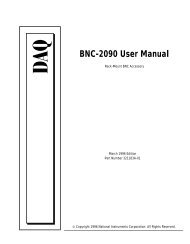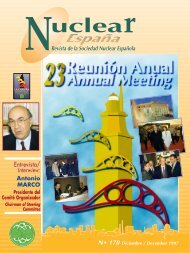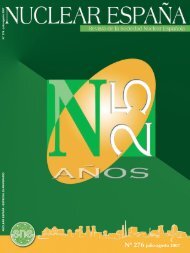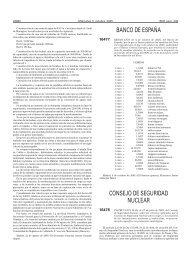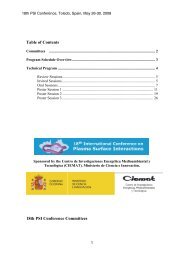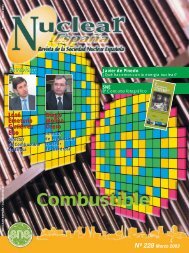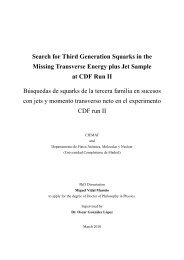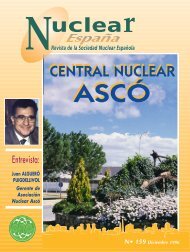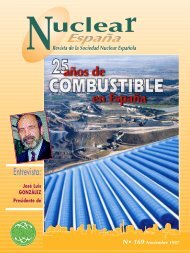EntrEntr evista/evista/ InterInter viewview
EntrEntr evista/evista/ InterInter viewview
EntrEntr evista/evista/ InterInter viewview
You also want an ePaper? Increase the reach of your titles
YUMPU automatically turns print PDFs into web optimized ePapers that Google loves.
INNOVACIîN TECNOLîGICA COOPERATIVA<br />
Y COMPETIVIDAD EN EL çMBITO NUCLEAR<br />
COOPERATIVE TECHNOLOGICAL INNOVATION<br />
AND COMPETITIVENESS IN THE NUCLEAR ARENA<br />
A. CASTRO - M. MARCO - R. SALVE - J. VALLEJO - J.A. TAGLE<br />
La I+D y, más recientemente, la<br />
innovación tecnológica y su<br />
vinculación con la competitividad<br />
son, cada vez con más frecuencia,<br />
elementos integrantes cuando no<br />
el núcleo central de conferencias,<br />
libros, artículos y discursos<br />
políticos. Las relaciones entre<br />
innovación tecnológica y<br />
competitividad no son, sin<br />
embrago, evidentes.<br />
El presente artículo trata de<br />
ilustrar algunos mecanismos que<br />
relacionan la innovación<br />
tecnológica con la competitividad<br />
a través de un ejemplo concreto,<br />
DTN, que está dando sus frutos<br />
en la industria nuclear y que<br />
puede contener elementos<br />
extrapolables a otros sectores<br />
industriales.<br />
La importancia concedida por<br />
el mundo nuclear a la innovación,<br />
a la investigación y al desarrollo<br />
tecnológico no es nueva ni<br />
patrimonio de ninguna<br />
organización en particular pero<br />
hace evidente la coherencia entre<br />
sus planteamientos tradicionales y<br />
la idea en boga de modernizar el<br />
país promocionando un tejido<br />
tecnológico nacional.<br />
INTRODUCCIîN<br />
La I+D y, más recientemente, la<br />
innovación tecnológica y su vinculación<br />
con la competitividad son,<br />
cada vez con más frecuencia, elementos<br />
integrantes cuando no el<br />
núcleo central de conferencias, libros,<br />
artículos y discursos políticos.<br />
Está de moda hablar de innovación<br />
y al socaire de la misma<br />
surgen multitud de iniciativas de<br />
todo tipo.<br />
De una concepción finalista de<br />
la investigación (es bueno investigar<br />
en sí mismo) se ha pasado a<br />
otra de carácter instrumentalista,<br />
imperativa y ampliada (es necesario<br />
innovar para generar bienestar<br />
social). El eslabón adicional en ese<br />
cambio conceptual es la competitividad<br />
(para generar bienestar hay<br />
que ser competitivo).<br />
Dejando al margen esta última<br />
consideración, la dificultad para<br />
entender y aplicar esa concepción<br />
radica en que no son evidentes ni<br />
universales los mecanismos que<br />
relacionan la innovación con la<br />
competitividad. De hecho, las<br />
campañas de promoción de "cultura<br />
investigadora", necesarias por<br />
otro lado, a menudo se basan en<br />
relatar ejemplos de empresas (o<br />
personas) para las que la innovación<br />
tecnológica ha constituido la<br />
clave de su desarrollo empresarial.<br />
El presente artículo se inscribe<br />
de algún modo en este marco: relatará<br />
un ejemplo más con el ánimo<br />
de ilustrar algunos mecanismos.<br />
Se pondrá de manifiesto<br />
cómo el sector eléctrico español,<br />
consciente del reto planteado por<br />
unas circunstancias socio-económicas<br />
cambiantes, diseñó y puso<br />
en práctica un modelo, a través de<br />
DTN, que está dando sus frutos en<br />
la industria nuclear y que puede<br />
contener elementos extrapolables<br />
a otros sectores industriales.<br />
La importancia concedida por<br />
el mundo nuclear a la innovación,<br />
a la investigación y al desarrollo<br />
tecnológico no es nueva ni patrimonio<br />
de ninguna organización en<br />
particular pero hace evidente la<br />
coherencia entre sus planteamientos<br />
tradicionales y la idea en boga<br />
R&D and, more recently, technological<br />
innovation and its relationship with competitivity<br />
are more and more part of conferences, books,<br />
articles and political speeches and very often are<br />
the central part of them. Innovation has become<br />
fashionable and many initiatives have come out<br />
in connection with it. However, the relationships<br />
between technological innovation and<br />
competitivity are not always obvious.<br />
The current article intends to illustrate some<br />
mechanisms that link these two concepts through<br />
a specific case, DTN, that is already providing<br />
results for the Spanish nuclear industry and<br />
whose example can be extrapolated to other<br />
industrial sectors.<br />
The importance given by the nuclear to the<br />
innovation, the research and the technological<br />
development it is not new either exclusively<br />
belong to any specific organisation but makes<br />
evident the coherence between its traditional<br />
approach and the current idea of modernising<br />
the country promoting the national technological<br />
capacity.<br />
INTRODUCTION<br />
R&D and, more recently, technological innovation<br />
and its link to competitiveness are increasingly<br />
component elements, if not the core issue, of<br />
conferences, books, articles and political speeches. It is<br />
fashionable to speak of innovation, and this leads to a<br />
multitude of initiatives of this sort.<br />
The concept of research as an end in itself (research<br />
on its own is good) has given way to a broader concept<br />
of an instrumentalist, imperative nature (it is necessary<br />
to innovate to generate social well-being). The<br />
additional link in this conceptual change is<br />
competitiveness (one must be competitive to generate<br />
well-being).<br />
Leaving this latter consideration aside, the difficulty of<br />
understanding and applying this concept lies in the fact<br />
that the mechanisms that relate innovation to<br />
competitiveness are not evident or universal. In fact, the<br />
promotional campaigns of the “research culture”, which<br />
on one hand are necessary, are often based on listing<br />
examples of enterprises (or people) that have found the<br />
key to their business development in technological<br />
innovation.<br />
This article to a certain extent fits into this framework:<br />
it will provide one more example for the purpose of<br />
illustrating some mechanisms. It will explain how the<br />
Spanish electricity sector, aware of the challenge posed<br />
by changing social-economic circumstances, has<br />
designed and put into practice, through DTN, a model<br />
A b r i l 2 0 0 0<br />
R e v i s t a S N E




